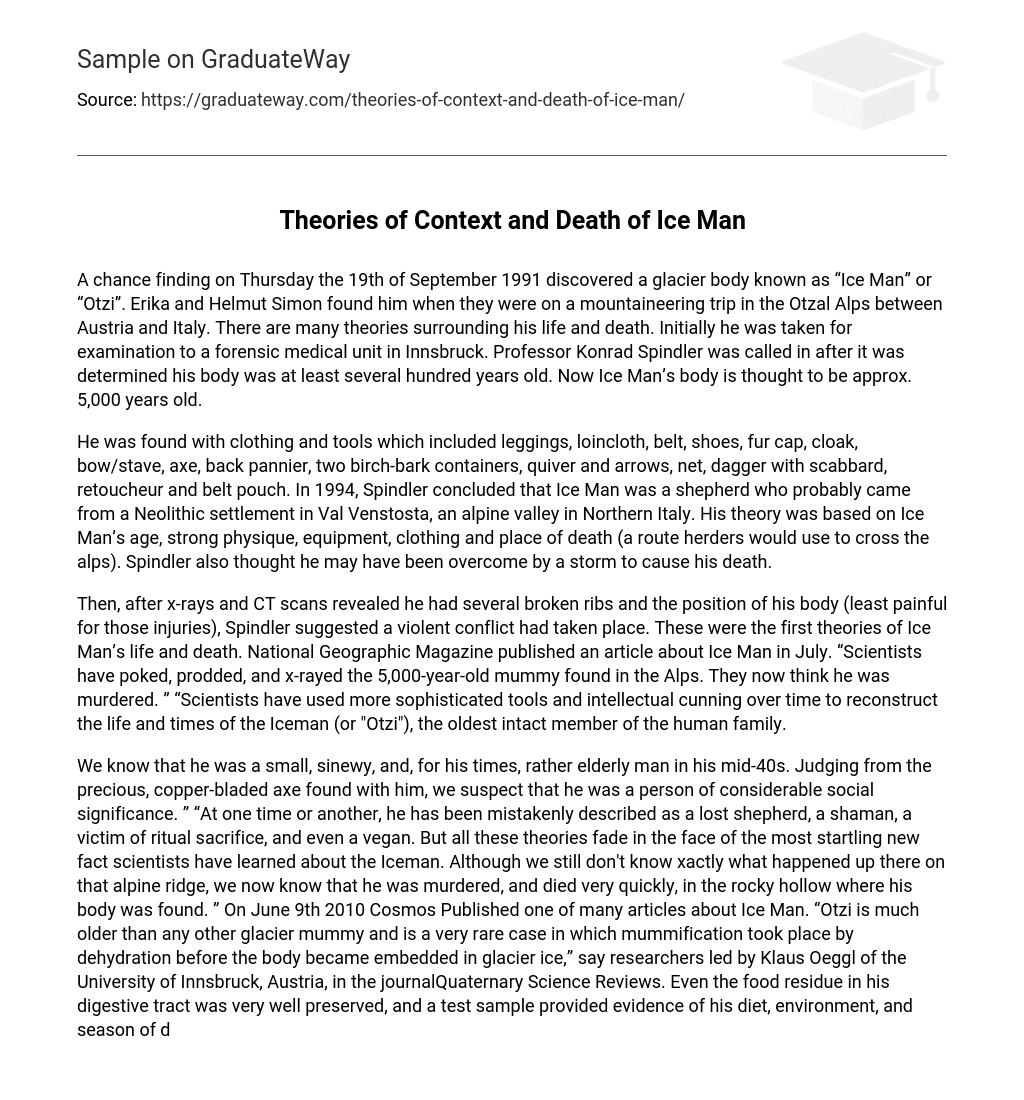A chance finding on Thursday the 19th of September 1991 discovered a glacier body known as “Ice Man” or “Otzi”. Erika and Helmut Simon found him when they were on a mountaineering trip in the Otzal Alps between Austria and Italy. There are many theories surrounding his life and death. Initially he was taken for examination to a forensic medical unit in Innsbruck. Professor Konrad Spindler was called in after it was determined his body was at least several hundred years old. Now Ice Man’s body is thought to be approx. 5,000 years old.
He was found with clothing and tools which included leggings, loincloth, belt, shoes, fur cap, cloak, bow/stave, axe, back pannier, two birch-bark containers, quiver and arrows, net, dagger with scabbard, retoucheur and belt pouch. In 1994, Spindler concluded that Ice Man was a shepherd who probably came from a Neolithic settlement in Val Venstosta, an alpine valley in Northern Italy. His theory was based on Ice Man’s age, strong physique, equipment, clothing and place of death (a route herders would use to cross the alps). Spindler also thought he may have been overcome by a storm to cause his death.
Then, after x-rays and CT scans revealed he had several broken ribs and the position of his body (least painful for those injuries), Spindler suggested a violent conflict had taken place. These were the first theories of Ice Man’s life and death. National Geographic Magazine published an article about Ice Man in July. “Scientists have poked, prodded, and x-rayed the 5,000-year-old mummy found in the Alps. They now think he was murdered. ” “Scientists have used more sophisticated tools and intellectual cunning over time to reconstruct the life and times of the Iceman (or “Otzi”), the oldest intact member of the human family.
We know that he was a small, sinewy, and, for his times, rather elderly man in his mid-40s. Judging from the precious, copper-bladed axe found with him, we suspect that he was a person of considerable social significance. ” “At one time or another, he has been mistakenly described as a lost shepherd, a shaman, a victim of ritual sacrifice, and even a vegan. But all these theories fade in the face of the most startling new fact scientists have learned about the Iceman. Although we still don’t know xactly what happened up there on that alpine ridge, we now know that he was murdered, and died very quickly, in the rocky hollow where his body was found. ” On June 9th 2010 Cosmos Published one of many articles about Ice Man. “Otzi is much older than any other glacier mummy and is a very rare case in which mummification took place by dehydration before the body became embedded in glacier ice,” say researchers led by Klaus Oeggl of the University of Innsbruck, Austria, in the journalQuaternary Science Reviews. Even the food residue in his digestive tract was very well preserved, and a test sample provided evidence of his diet, environment, and season of death. ” Oeggl’s team have used the remains of Otzi’s last meals.
The contents, including ibex, red deer meat, grains and pollen, have been used to reconstruct the last 33 hours of Otzi’s life. Chips of mica suggest the wheat and grains he ate had been ground down; specks of charcoal may have come from making bread and baking it in an open fire. They also found other information on Ice Man such as the colour of his eyes and other facts regarding his teeth, hair, fingernails, injuries and many other details about Otzi. In 2012, Albert Zink has discovered new evidence. He collected the first samples of red blood cells (previous attempts failing) from Ice Man’s wounds. Zink says they look just like modern blood cells “There was no difference, although they were a little more brittle than living cells. ” (Journal of the Royal Society Interface, DOI: 10. 1098/rsif. 012. 0174). Traces of the blood-clotting protein fibrin came from the wound on his back, caused by the arrow that killed him. The fibrin is evidence that the wound was fresh when the iceman died. The cells are at least 2,000 years older than those from Egyptian mummies, the previous record-holders. From the evidence found in, on and with Ice Man we can determine the most likely cause of death for Ice Man, what he did and who he was. Ice Man died of blood loss from an arrow and was of high social significance.





